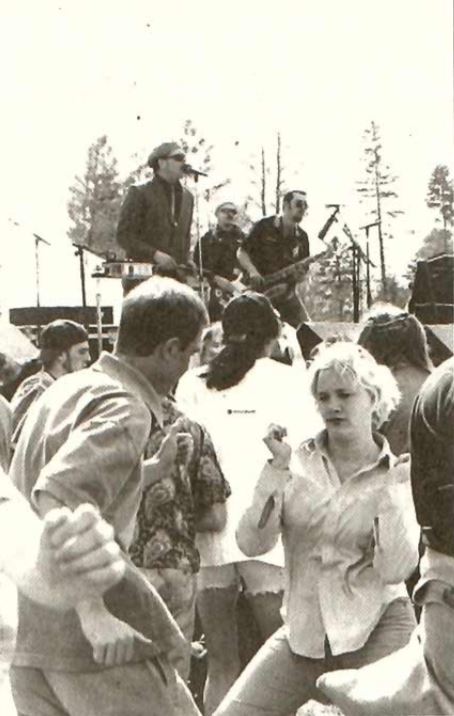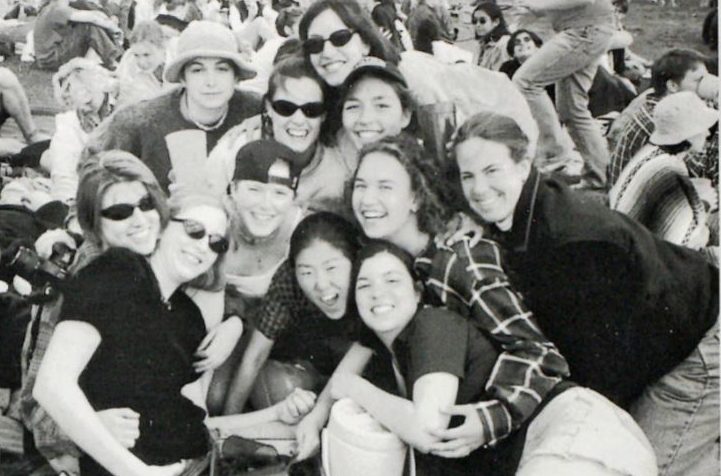In 1984, if you were looking to catch your favorite band live, you flipped to the back page of Rolling Stone. That year, listed among the tour stops for the band NRBQ, was Carleton College’s Spring Concert. “The administration freaked out,” Sarah (Ladner) Maris ’85 says. In February of that year, a Carleton dance featuring The Replacements, known for their rowdy fans, also made it into Rolling Stone. Although that concert went smoothly, after the second Rolling Stone advertisement, Dean of Students Cris Roosenraad decided Spring Concert ’85 would be the last, citing liability concerns in a May 17, 1985 article of the Carletonian.
In addition to NRBQ, Carleton also booked Lonnie Brooks, Koko Taylor, and the Gear Daddies in its early years of the Spring Concert. “Colleges used to play an integral part in national touring markets,” said Carleton music professor Andy Flory. “When baby boomers started going to college, the budget for entertainment swelled considerably.”
By the time Spring Concert began in 1981, college radio stations played a major role in marketing lesser-known bands. “Late-1970s rock music became huge, with lots of corporate conglomerates, but there’s always been a push and pull between large corporate music and small grassroots-type things,” Flory notes. “Colleges were the perfect place to house that off-the-beaten-path rock music.” College radio stations like KRLX helped bands like Talking Heads and REM gain a wider following, and college towns like Northfield were good stopping points for bands on the road on a shoestring budget.
Spring Concert, which was conceived with St. Olaf, was always intended to stand out from other events in the calendar. “We would get one big marquee band, someone that neither campus could afford otherwise, and a couple of warm-up acts,” says Sarah Maris ’85, co-chair of Co-op, a student-run precursor to the Student Activities Office (SAO) funded by the Carleton Student Association (CSA). Each year Co-op met with representatives from their counterpart at St. Olaf, the Student Activities Council (SAC), to choose bands. Carleton handled most of the set-up and clean-up, including putting together the scaffolding for a professional stage: “You could see for miles from the top” says co-chair David Boudreau ’85.
“It was the only time that the two campuses ever got together except for the football game in the fall,” says Maris. But she acknowledges, “The Carleton people tended to hang with the Carleton people and the St. Olaf people with the St. Olaf people”
Walk between a Carleton and an Olaf picnic blanket and you might not know whose event you were at. The Oles preferred the moniker “Arbstock.” However, they recognized it never caught on with Carls: “Do not call it Arbstock in front of any of them. They hate it!” warned St. Olaf’s student newspaper, the Manitou Messenger, in May 2003.
For the most part, the colleges could agree upon the bands. Except, notably, in 1990. While Carleton was on Spring Break, the Olaf Student Activities Committee (SAC) booked Canadian rock guitarist Pat Travers to headline when the mutually-agreed-upon first choice fell through. In an April 27, 1990 Carletonian, Co-op co-chair Michelle Coffey ’91 said, “Olaf will enjoy it because that’s their type of music. But I don’t think Carleton students will have a good time.” Feedback collected by the Co-op after the concert largely confirmed Carls’ displeasure, according to a May 25, 1990 Carletonian.

By Eric Gerecke ’91.
Since it was hosted at Carleton, for the Oles, Spring Concert presented a unique opportunity to drink at a school-sanctioned event. At the Hill of Three Oaks, kegs were plentifully supplied by the Carleton Co-op. The rain location, however—St. Olaf’s Skoglund Auditorium—was a dry venue. When bad weather necessitated moving to Skoglund, as it did in 1988, Carls expressed concern that it drove drinking dangerously underground.
In 1986, the drinking age in Minnesota rose from 19 to 21. With the majority of Spring-Concert-goers now underage, the two colleges’ differences in approach to alcohol and enforcement became more pronounced. In developing a plan for the concert to satisfy their insurance agency, St. Olaf’s Director of Student Activities told the Manitou Messenger, “We [St. Olaf] started with a real conservative proposal and they [Carleton] came up with a no-holds barred one.” For 1987, the schools’ administrations, with input from student leaders, settled on privately registered kegs and wristbands for those ages 21 and up. In 1989, they switched to a more restrictive beer garden.

Setting up for Spring Concert, 1986. / Algol Yearbook. 
Dancing at Spring Concert in 1997. / Hannah Koenker ’00 for the Carletonian.
Concerns surrounding alcohol continued for St. Olaf administrators, and for Carleton Co-op chairs and students. In 1991, Co-op chairs Sara Fielder ’92 and Chris (Cornils) Bent ’92 received some 40 comments that the drinking had gotten out of hand and several that women felt unsafe at the event: “Spring Concert in recent years all seem to center around the availability of alcohol. It is a sad fact that Spring Concert has become an excuse for students to forget all that they have learned about being respectful to other students, cultures, and genders,” they wrote in a May 25, 1990 issue of the Carletonian. Campus Activities Director, Jeff Sturkey, said he would be hesitant to approve a concert like the one they had.
Scheduling issues, disagreements over alcohol and concerns that Carleton bore the brunt of the work strained the colleges’ partnership, which officially ended in 2003. According to St. Olaf’s Dean of the College, Greg Kneser, in a May issue of the Manitou Messenger, changes to the event that may have allowed Olaf to stay involved would have included fencing in the concert area, increasing security, and requiring wristbands for those over 21. “But Carleton didn’t want to make changes for our sake,” he reported. Since then, Carleton has come to adopt many of these policies.
Despite a large budget (a total of $124,000 last year, according to the Carletonian), the Spring Concert Committee today may have a harder time booking bands than in the past. Professor Flory explained: “The touring industry today is more corporatized and consolidated than it was in the eighties. Bands are planning tours farther out and our nine-month schedule doesn’t really fit.”
Flory also noted that because the concert is largely student-run, there is a lack of institutional knowledge: “They don’t know what they’re doing, because how would they know what they’re doing?” Despite these challenges, Flory focused on the value of students having the opportunity to learn on-the-spot with significant resources: “I am really supportive of the student-run model. Who cares if it’s slapdash? It’s their slapdash concert!”
Sergio Demara ’20, member of the Student Activities Programming Board (SAPB) and one of the chairs of this year’s Spring Concert Committee, explained the committee-selection process: “We sent out an interest form at the beginning of winter term. The committee includes students from each class year, members of SAPB, and staff from the Student Activities Office.”
The team follows a tight schedule though the term with weekly goals and discussions. Artist availability is a driving factor in their research, as are videos of their live performances. “Our discussions consider which artists are popular amongst the students,” said Demara, distinguishing their goal from the Cave’s focus on up-and-coming artists. Before campus closed, the committee had not made any final decisions on performers or spent any of their budget.

Brit Fryer ’15, former student DJ, still wonders how the 2015 Spring Concert Committee managed to book T-Pain. “He is one of the best live performers in the world, and I stand by that,” said Fryer. Fryer opened for T-Pain with his DJ set: “It’s one of my two truths and a lie. It gets people every time.”
Backstage before his set, Fryer brought an unfinished clay teapot his friend had made, which she was hoping T-Pain would carve his name in. Picking up a stick, Fryer said to the rapper, “Can you sign this? My friend really needs it.” T-Pain looked confused, Fryer says, but he did it.
“A lot of people can enjoy Spring Concert in different ways,” said Fryer, “No matter what you do at Carleton, it’s still fun. It’s laying in the grass and listening to music.” Demara agrees. “Spring Concert means that I invite the ideas and creativity of the entire school for a night that brings out our happiest selves,” he said.













Erik Gearhart ‘91 • Mar 13, 2022 at 11:39 am
Thanks for this look back! Vouch for many of us scratching our heads at Pat Travers that year. I still remember the band taking the stage and announcing “I know a lot of you don’t know us, but we are a real famous rock band.” Audible derision followed for the entirety of the set.